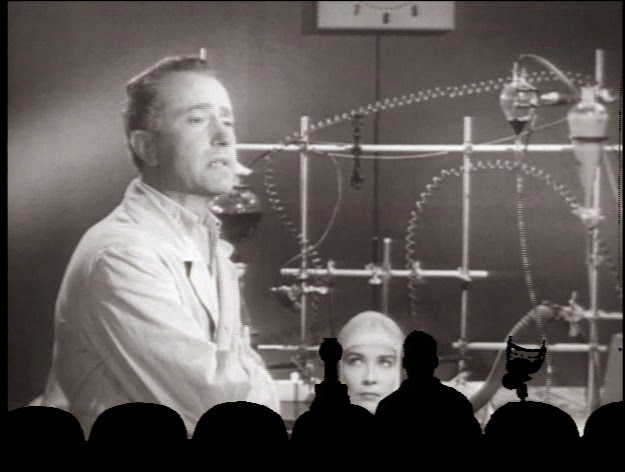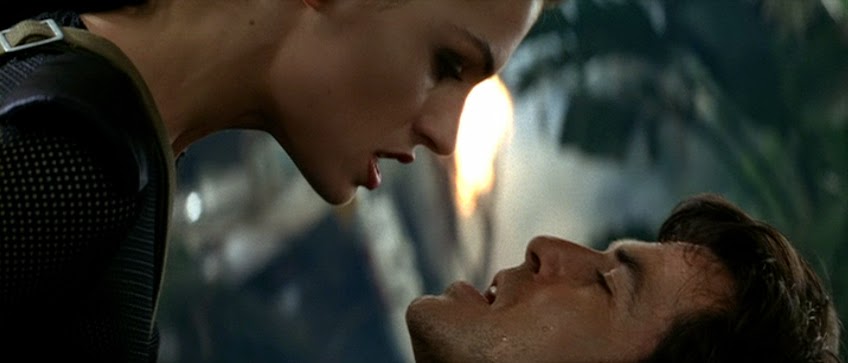Dr. Bill Cortner (Jason
Evers) is a brilliant surgeon who saves lives with his daring and innovative
techniques. But this skill comes at a cost. He is obsessed with full limb
transplantation, and experiments with cadavers and his hapless assistant Kurt
(Anthony La Penna) in his spare time. He is very close to being able to
transplant a dead arm to a living body with no nasty side effects. He’s about
to show his girlfriend Jan (Verginia Leith) his secret laboratory when the
moron goes and crashes his car. Bill is thrown clear, and so is Jan… well her
head anyway.
Bill races with Jan’s head
back to his hidden lab and using his secret serum he manages to resurrect Jan’s
head! Now all he needs is a body. Bill figures it is time for an upgrade so he
starts looking for all the smokin’ hot girls he can find, and decide which one
he will decapitate and bring back to his lair. In the meantime, Jan is not
pleased with her fate. But she discovers that the serum has given her
telepathic abilities. She can communicate with one of Bill’s mistakes hidden in
a closet. Will Jan cause havoc before Bill can find a body, or will he end up
facing his former love: The Brain That
Wouldn’t Die.
Movie Review:
 |
| "So he's a scientist you see." |
I’ve actually seen a tamer
edit of this film, which moves a bit better in the pacing department. Gone are
all the scenes with Bill attempting to pick up sleazy women. Instead it is much
leaner and meaner approach. But the crew of Mystery Science Theater went for the longer cut of The Brain that Wouldn’t Die and I have
to say it was a wise choice.
Visually the film has some
interesting moments. When Bill retrieves Jan’s head, the whole scene is filmed
with a frantic hand held approach. Surprising to see in a black and white B
film. We also get lots of point of view shots, usually as Bill sizes up his
victims. But we get a few shots from Jan’s severed head angle.
 |
| "I hate ALL MEN!" Yes, yes, you've said it three times already. |
Overall the special effects
are low budget fun. Jan’s head in the pan is pretty nifty. The make up effects
for the mutant, and the bloody violence as Kurt and Bill get attacked are
handled pretty well. I was surprised by the amount of gore in the film. Didn’t
know we were getting into that much blood letting until the later 60s. On the
flip side, the operation that opens the film is pretty laughable, especially
the patients vinyl skull.
The sound effects work well
enough. But the music in The Brain and
Wouldn’t Die is a curiosity. When Bill is cruising for a new body, the
score kicks into some saxophone heavy jazz. I’m not sure what they are trying
to imply here, but I kept waiting for a 90s Skin-a-max movie to kick in. The
music used for the creepy moments is stock stuff. If you’ve seen enough of
these movies you’ll probably recognize it. Most of it works fairly well
actually.
 |
| Kurt does his Johnny Tremain one man show. |
In the ladies corner you
have Leith as Jan. It must have been a tough shoot for her, and I admire her
dedication to this very silly movie. She has to talk in a raspy voice for about
85% of her dialogue. But she has the angry stare down pat. When she declares
vengeance on Bill, you believe it. There is also Adele Lamont as Doris Powell.
Doris is the unfortunate gal who Bill brings home to be the new body for Jan.
Doris has a great body, but an angry boyfriend cut up her face. As a result she
hates all men! She declares this on several occasions. Bill manages to convince
her that he can help, but of course his help is just chopping off her head and
tossing it away. Lamont plays the whole thing very broadly, and it is a bit of
as shame since the character is supposed to be one you feel bad for. Most of
the time I was just wondering how annoying she could really get.
As for the script… do I
really need to discuss it? With a title like The Brain that Wouldn’t Die you pretty much get what you expect. The
plot is ridiculous; the dialogue is extremely ripe and filled with great lines.
It lacks the clumsiness of Ed Wood’s script work, but gives Bill plenty of
dialogue with sinister alternate meanings. In it’s basic form, the script fits
the title.
 |
| The 1962 model Floozy! |
Is the movie an effective
scare machine? Not really. But The Brain
that Wouldn’t Die is a fun monster flick with a lot of riffing potential.
It was the perfect first flick for Mike to tackle as the new host of Mystery Science Theater 3000.
Episode Review:
 |
| Jan in the Pan! Neck juice not included, some disassembly required. |
With Joel leaving, the crew
at Best Brains decided to give the show a bit of a facelift. First off they had
to create new opening credits (since the originals featured Joel in the visuals
and in the song). They kept the same tune for the opening credits, but changed
the lyrics to reflect Mike’s misadventures as they occurred in the episode Mitchell. These include Mike getting
hit on the head with a clown hammer and shot into space. The new opening
credits even feature a clip from this episode: The Brain that Wouldn’t Die.
 |
| Doris is not buying Mel Blanc's pick up lines. |
This was actually a great selection
of movie for a transition episode. The
Brain that Wouldn’t Die falls in the familiar territory for the writers.
It’s black and white, a monster movie, it’s got a goofy mad scientist, silly
music and ridiculous dialogue. Let’s keep in mind that Mike had been head
writer for years, and had performed in front of the camera numerous times
playing characters like Gamera, The Amazing Colossal Man and of course
Torgo from Manos: The Hands of Fate.
The big difference here is that Mike would be taking a center stage role. And
he handles himself well.
 |
| "The road is attacking me!!!!" |
Of course with the title The Brain that Wouldn’t Die, things
really get cooking when Jan’s head is placed in her pan with neck juice (Mike
and Bots words, not mine), and she comes back to life. They dub her “Jan in the
Pan” and they get a big kick out of her constant lamenting her fate. When Bill
reveals Jan to his assistant Kurt, he says, “What you see is real.” Mike adds,
“What you smell is unfortunate.” Later, when Jan and Kurt are verbally
sparring, and Kurt is losing badly Tom imitates his bluster with a “Shut up you
stupid little pan woman!” When Jan bemoans “Why did he let me die?” for the
millionth time, Crow bursts out, “You still on about that? Well we got problems
too lady!”
 |
| Awww, it's true love. |
The finale, in which Bill
brings Jan her new body and Jan unleashes her final retribution features wall
to wall riffing fun. As Doris is laying under a sheet, and her prominent chest
is jutting forth, Mike asks as Bill “But honey, can you say no to these?” Her
answer is to bring forth a monster that Crow declares “looks like Boo Radley!”
The creature manages to grab Bill through a tiny hole in a door (don’t ask,
just watch the movie. It actually makes some sense). The boys offer helpful
hints to the monster, “You know just pull the door away and beat him to death
with it.” At this point, Bill is no longer our wacky protagonist, but a grade A
jerk. As the film ends with everyone trapped in a burning laboratory, we hear
Jan laughing. Mike says, “Oh, it was a comedy!” Well Mike and the bots
certainly made it funny.
 |
| Mike an the bots are proud of their hats for Jan in the Pan |
The Brain that Wouldn’t Die is a fun episode. The riffing is solid, the movie is
ridiculously watchable and it makes for a great transition episode for the
hosts. In the scheme of things, it sits in the middle of Season Five, but it is
well worth seeking out.
I give it three heads in
pans out of five.
This episode is available on the single DVD from Rhino, but was also
included on a disc with Mitchell in
the Mystery Science Theater 3000 25th
Anniversary Edition boxset.



























